
On my first weekend in Merida, Mexico, I asked the receptionist at Casa Garza Hostel for suggestions on where I could go on a half-day trip. He suggested a place I hadn’t heard of or read about on any must-do blogs—the nature reserve in Progreso called El Corchito. “They have mapache,” he told me. “You know mapache? What is the word for this…?” and he showed me a photo of a raccoon on his phone. I knew without needing to do any further research that I had to go find this secretive and magical raccoon land.
To get there, I had to take a bus to Progreso Beach. A lot of people visit Progreso from Merida on group tours that costs $100 without ever bothering to consider if it’s just as easy to do on their own. If you’re from the United States, one thing to remember when traveling in very affordable places is that the tours are specifically marketed to people who are NOT local, so prices for tours are typically closer to what you’d find for the same activity at home. In Mexico, most of the day tours I did with companies were between $75 and $125, so I only did those tours if the activity was something that would have been difficult or impossible to do via public transportation. I’m a fan of group tours in the right circumstance, but it’s always worth checking to see if you can save money by doing the same activity on your own.
Going to Progreso consisted of this:
- Going to the bus station.
- Paying like $1.50 USD for a bus ticket.
- Getting on the bus.
That was it.
The ride was a little under an hour long, and we picked up passengers at a second stop, so it was standing-room only for the last half of the ride. But it was air-conditioned and well-worth the $98.50 I saved.
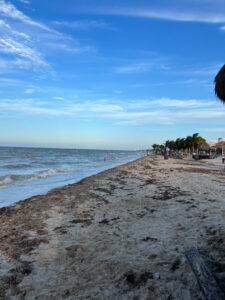
After arriving in Progreso, I took an Uber to the entrance of El Corchito (about a $3 ride). They are very strict at the reserve about preservation and leaving nature as you find it, so all food and sunscreen is prohibited. After storing forbidden items in a locker and paying the entrance fee, I waited on a dock for a boat to take me across a lagoon to the nature reserve. We crossed a wide river and then into a narrow tunnel of mangrove trees until we arrived at the tiny dock. As soon as we landed, I saw the raccoons. They were everywhere—dozens of them. In the trees, lurking around the lockers, on the mangrove roots.
I had known to expect the raccoons, but I hadn’t known to expect the coatis. I had never even heard of a coati until just a few months before when I happened upon a photo of one and desperately searched online until I found what this mystical creature was called. It is difficult for me to find words to express my delight at unexpectedly discovering them in person.

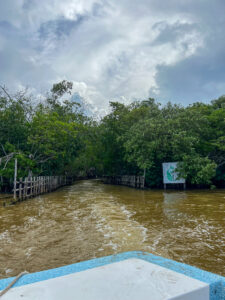

As I moved farther into the reserve, I started seeing them and audibly gasped. They were more timid than the raccoons but still lurking nearby, waiting for a surprise snack to appear. (Food not allowed on the grounds, but this didn’t deter them from hoping.) The raccoons and coatis roam freely at the reserve, totally unbothered by the visitors who come to swim in the cenotes and take pictures of them.
The reserve is tiny—just two above-ground cenotes (like swimming holes) next to each other and then another one down a path a few hundred yards away. I wasn’t interested in swimming, though. I spent a while gazing at the animals in awe and obsessing over a mother raccoon who was grooming her baby before I took a boat back across the lagoon and Ubered to the beach.
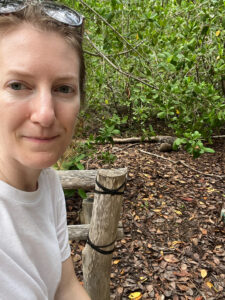
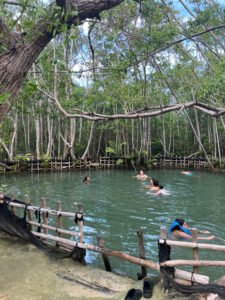


Progreso is on the northern side of the Yucatan Peninsula—the Gulf of Mexico side instead of the Mayan Riviera side where all the popular resort towns are. The beach there is not gorgeous like the Mayan Riviera. It’s a small, local beach town that seems unconcerned with glamour or modern updates. I was surprised to learn that cruises frequently dock in Progreso because I wouldn’t imagine this is what most people are expecting when they plan to spend a day on a Mexican beach. Before visiting, I’d considered spending a night or two in Progreso, and I’m glad I didn’t. The restaurants, beach clubs, and shops along the promenade were overpriced and full of the kind of tacky souvenirs that I didn’t see much of in Merida, and the rest of downtown didn’t look particularly inviting to me. As someone who wasn’t interested in baking on a beach in 90-degree humidity, I’m also biased. A person who loves sunbathing could easily spend a day there.
Someone told me that about a decade ago, a ferry used to run between Progreso and New Orleans—it’s a direct shot and about 600 miles north. The longest pier in the world—4 miles!—stretched toward New Orleans in the distance.
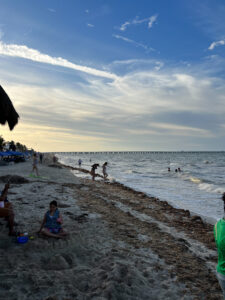

I ate lunch at a restaurant that I read in multiple blogs was the best in town—a seafood restaurant called Crabster where I paid an amount that still pains me to think about for shrimp tacos. (Though they were admittedly some of the best shrimp tacos I’ve ever had.) Then I went in search of the main reason I went to the beach—the Meteorite Museum.
I didn’t know until embarrassingly recently that scientists believe the asteroid that caused the ice age that killed the dinosaurs (and most everything else on land) hit near Progreso/Merida, just a few miles off what is now the coast. (At the time, the whole area was under water.) The impact created what’s called the Chicxulub Crater which covers a big section of the Yucatan Peninsula. (Am I the only person who never learned this in a science class? I LIVE a few hundred miles from this crater—how did no one ever tell me?)
The impact of the asteroid is what created all the cenotes (like underground sink holes that people swim in today) in this region. You’d think that the meteor fact would be a far more commercialized tourist draw, but it’s really not. I wanted to learn more about it, and I was thrilled to find that Progreso opened a Meteorite Museum in 2022.
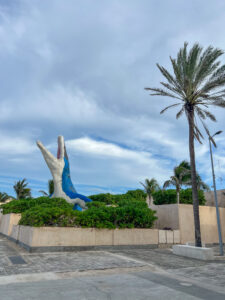
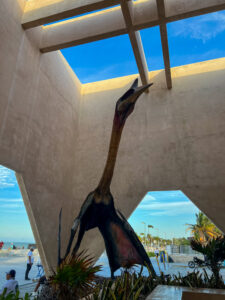
The museum is not the type of museum where you wander at your own pace and look—it’s a guided experience where you go through exhibits with a group. I was devastated when the lady at the ticket booth told me there were no more English tours for the day, but she said it would be okay if I went with the Spanish tour instead.
And in spite of my less-than-elementary understanding of spoken Spanish, it worked out fine! I used the Google Translate app with voice dictation, and it translated everything the guide said to English text for me so I could read it on my phone while she talked. She only found me out at the very end. There I was, the only person facing the English-translation big screen in the room that showed the video of the re-imagined meteor strike and fall-out on all four walls. “You’re standing where life changed forever,” the sub-titles said, and I felt like that was really downplaying the situation. Then the walls opened up, and animatronic dinosaurs started turning their heads to look at us. It sounds absurd, but I’m telling you it was fantastic.
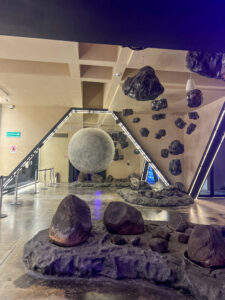
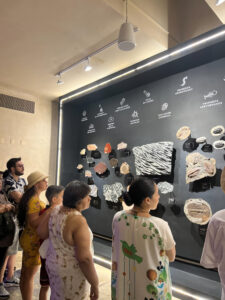
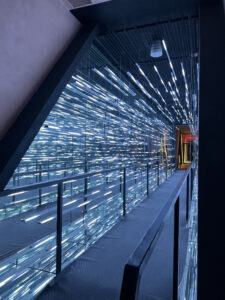
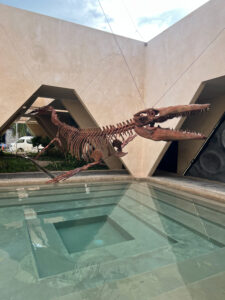
I headed back to Merida before the sun set. Even though I barely set foot on the sand and didn’t touch the water, I still recommend a day trip to Progreso from Merida to see the raccoons and coatis, learn about the meteor, and to eat over-priced-but-delicious seafood with an ocean view.
